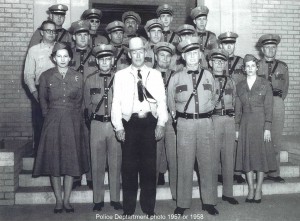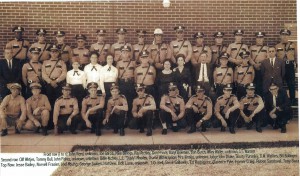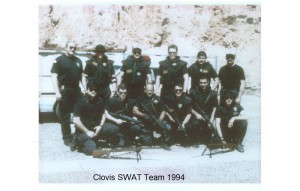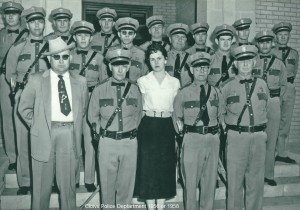“The Beginnings”
When Clovis was founded in 1907 by the Santa Fe Railroad the law was the sheriff of Roosevelt County, a county that stretched up to the southern boundary of Quay County. Both of these counties had been organized in 1903. Clovis was a railroad town established when the railroad built their Belen Cutoff from Texico to Belen, NM The railroad’s townsite company laid out the streets and the railroad furnished security for the railroad construction gang building the roundhouse, shops, depot, etc. The railroad oversaw the development of this new town and furnished what “law” was necess ary.
ary.
In 1908, less than a year after Clovis had been decreed a town and had elected it’s first governing body, the Governor of New Mexico, under due process of law, ordered and decreed that Clovis be declared a City. Five trustees were elected, one of them being the head of the railroad’s townsite company. They then began the tedious task of writing ordinances under which the town would be governed. Within two years after the town was formed the most active and influential businessmen of Clovis went to Santa Fe, NM to petition Governor George Curry for a new county. They were successful, after promising the governor the county would be named after him. In a following election, Clovis beat out three other small towns in the area and became the county seat. The governor appointed county office holders and a Sheriff, C. H. Hannum.
The trustees of the City of Clovis, in June of 1909, six months after Curry County was organized, finally got around to putting some ordinances in force. Ordinance No. 12 provided for the appointment of two City Marshals whose expressed duties, said our first historian, the late Tom Pendergrass, “covered everything from arresting criminals to changing the baby.” Ordinance No. 39 passed on April 27, 1911, outlawed brothels and bawdy houses, which, in 1978, Tom Pendergrass said, “was still on the books.”
The late Dr. I. D. Johnson, a longtime dentist in Clovis, remembered the first law officers here, being a young boy growing up in this exciting new town. “First there was Frank Ivy who rode a gray horse up and down Main Street. He wore a big high crowned hat and a handle-bar mustache with his “Chihuahua” spurs that jingled; he looked like a lawman. Course they were called ‘Marshals.’ Next came Dick Moye, rather slender in build and a quiet appearance. He rode a tall sorrel horse, but not on Main Street. He hated gamblers and one day he shot too quick.” (Dr. Johnson never did explain what he meant by saying “he shot too quick.” It could have been he shot an “important gambler” and was fired).
“Then there was Doug Hammond (some spelled it “Dug”). He came over from Melrose after the railroad gave up on Melrose and chose the site of Clovis for their roundhouse, etc. He was a rancher, a good man with a gun, very robust with a powerful build, standing about six-foot-two. He not only was a Marshal in Clovis but a Fireman as well.
“The biggest man of all was Finis A. Sadler. The Clovis News, on Jan. 1914 printed: ‘he was six feet and nine inches tall and weighed 230 pounds, with no fat.’ He made his arrests without help. Finis Sadler died at age 86 in 1949.
“The 1940’s into the 1980’s”
Many other lawmen served Clovis, but the name Marshal was dropped in favor of “Policeman.” Some of these law officers became well known and revered. One was Nelson Worley, the youngest policeman to have been hired by the City of Clovis in 1941. The police department grew from 10 patrolmen in 1941 to 17 in 1948 and by 1982, Worley said, the department had 67 employees, which included dispatchers, file clerks, and secretaries as well as patrolmen. Police Chief Nelson Worley said in 1941 the police department had two police units (vehicles). Most of the patrolmen were on foot patrol. Worley said that at that time the police used one-way radios instead of the two-way radios used today.
The policemen’s manner of communicating with each other was rather unique. When the one-way radios were used, the dispatcher would signal the patrolman by turning on red lights in different parts of the city. The red lights were located on top of the Hotel Clovis, one in the 500 block of Main and one on top of the old Kimo Hotel then located in the 100 block of W. Grand. When the policemen saw the light they would go to a nearby telephone and call the department to find out where they were needed. The two-way radios were put into service in 1946, said Worley. (And by 1982 the department had 11 units.)

When Worley first came to the police department in Clovis, he said to be a policeman “you handed the man a gun, a badge, deputized him, and put him on the street. In 1982 the department required all patrolmen to have a high school diploma, to pass a background check, and to pass an oral test and written examination. Worley said if the person is selected for the job, he had to take a seven-week basic training course at the New Mexico Law Enforcement Academy during the first year of his employment. The patrolman is on probation for the first six months.
The department in 1982 had a continuing education program for all police personnel. Every two months a class was given to familiarize policemen with any new laws. A school was also given after new decisions were made by the New Mexico State Supreme Court and the US Supreme Court to brief personnel on changes in the law.
The laws, rules, and regulations governing law enforcement have changed tremendously, Worley said. In the 1940s, Worley said it was not uncommon for a person arrested to be sent to the penitentiary the following day.
By 1982 the department had changed from routine police work to neighborhood patrolling. Neighborhood patrolling is where the same officers stay in the same district at all times. This makes it easier for the patrolman and the neighborhood residents. “It gives the residents of the neighborhood and the patrolmen a chance to get acquainted and know what is normal for the area,” Worley said. He also stated that the starting pay for a patrolman today (1982) is one and a half times better than it was in the 1940s.

By 1982 Worley had been in the law enforcement field for more than 30 years. Not only did he work his way up to be Chief of Police, but won 4 elections to become the Curry County Sheriff, in 1960, 1962, 1966, and again in 1968.
Sadly, former Chief Nelson Worley passed away on February 8, 2004, in Clovis at the age of 86. Chief Worley was given full police honors at his funeral and burial by the Clovis Police Department Honor Guard. The Clovis Police Department Law Enforcement Center located at 300 N. Connelly Street in Clovis is named in his honor.
(History graciously compiled by the late Don McAlavy, Clovis Historian)

